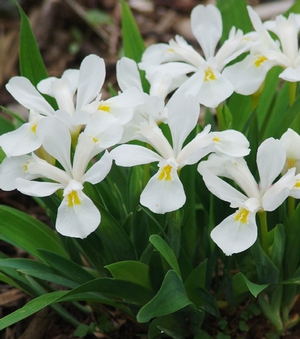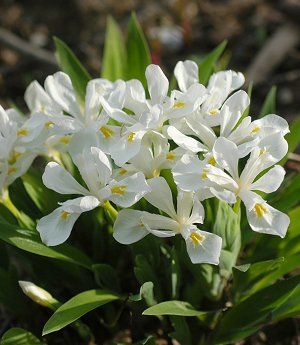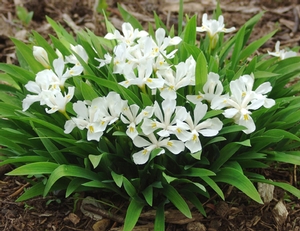Iris cristata 'Tennessee White'
Common: dwarf crested irisIris cristata 'Tennessee White' - 50 per flat
- Height: 6"-10"
- Spread: 12"-15"
- Spacing: 12"
- Hardiness Zone(s): 5-8


Iris cristata 'Tennessee White' - 50 per flat


This delightful selection of our native crested iris came to us from Don Shadow in Winchester, TN. 'Tennessee White' is a vigorous spreader and prolific bloomer, covering the fan-like foliage with brilliant white flowers in spring, each accented with delicate yellow crests. Its late spring show starts earlier and lasts longer than the other selections we've tried.
Prefers rich, well-drained soils in full to partial shade. If grown in full sun, the soil must remain consistently moist. Benefits from the addition of lime and rich, organic materials. Is rhizomatous and can be propagated by division after flowering is done with a sharp spade or pulling apart entangled rhizomes (which actually give rise to healthier plants). Best used as a seasonal groundcover, in rock gardens, or added for woodland color.
The iris was said to have first been adopted as an emblem in the 6th century by King Clovis of the Franks, after a clump of yellow flag iris had shown him where he could ford a stream and escape a superior force of Goths. It was revived as an emblem, the Fleur-de-Louis, in 1147 when Louis VII of France set off on the ill-fated second crusade. The emblem has been used since 1180 as a badge of the kings of France, and although referred to as the "Lily of France," was probably I. pseudocorus. The iris has been adopted by many kings since and has represented the birth of Christ in many classical paintings. Not to be outdone, even the Canadian Province of Quebec uses the Fleur-de-lis on her provincial flag. Countries of the world seem unabashedly attached to the beauty of the iris and in any one garden, English, Spanish, Dutch, Persian, German, Californian, Japanese, Lousiana, Pacific Coast, and Siberian irises may be found. - Herbaceous Perennial Plants, Allan Armitage